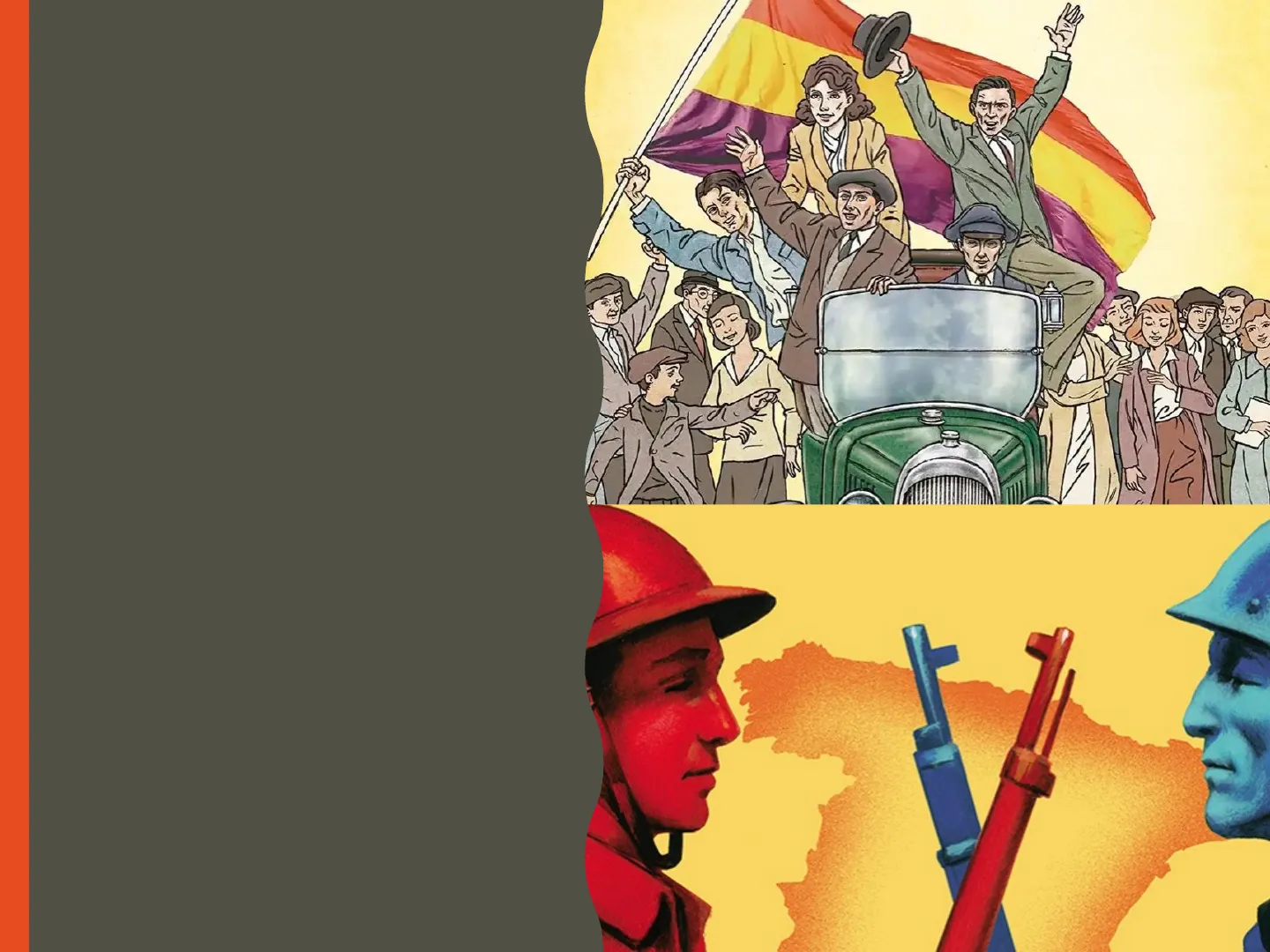The Second Republic and the Civil War: Reforms and Opposition
Slides about the Second Republic and the Civil War. The Pdf explores the Second Spanish Republic and the Civil War, detailing key reforms in agriculture, labor, and education, including statistical data on school creation. This High school History document, presented in slide format, includes an index of topics and questions for reflection.
See more52 Pages


Unlock the full PDF for free
Sign up to get full access to the document and start transforming it with AI.
Preview
The Second Republic and the Civil War
UNIT 6. THE SECOND REPUBLIC AND THE CIVIL WAR. DAVID PARDOS GRAOTHE SECOND REPUBLIC
- Index:
- Municipal elections
- A new constitution
- Equality for women
- Reformist biennium (1931-1933)
- Reforms undertaken by the Republic
- Opposition to the Republic
- The Conservative Biennium . The Triumph of the Popular Front . The miitar coup took shape.
Municipal Elections of 1931
MUNICIPAL ELECTIONS
- The municipal elections on 12 April 1931 were seen as a choice between a monarchy and a republic. Those opposed to the monarchical regime (Republicans, socialists and left-wing nationalists) created a coalition for the elections (Pact of San Sebastián, 1930). The monarchist parties, on the other hand, were divided.
- The elections resulted in a greater number of councillors for the monarchist parties. However, the Republican victory in cities (41 provincial capitals) and industrial areas reflected a desire for political change. Faced with the situation, Alfonso XIlI suspended royal authority and went into exile.
General Elections (June 1931)
ELECCIONES GENERALES (JUNIO 1931) 119 1 165 692 279 2 881 056 41 657 872 izquierda centro derecha 41: número de escaños 657 872: número total de votos
- Thousands of citizens took to the streets and the Second Republic was proclaimed on 14 April 1931. A provisional government was formed, with Niceto Alcalá-Zamora as prime minister.
- He called for elections to the Constituent Cortes. The elections were held in June and the Republican parties won by a significant majority.
- The new government included members of left-wing and nationalist parties. President Manuel Azaña promoted the drafting and approval of a new Constitution, which entered into force in December 1931
Alfonso XIII's Exile Statement
TEXTO: EL EXILIO DE ALFONSO XII Sunday's elections have shown me that I no longer enjoy the love of my people. ( ... ) I am the King of all Spaniards and I am a Spaniard. (.) I am determined to have nothing to do with setting one of my countrymen against another a in fratricidal civil war. I renounce none of my rights, which are not mine but are an accumulated legacy of history ( ... ). I shall await the true expression of the collective conscience and, until the nation speaks, I shall deliberately suspend the use of my royal prerogative and leave Spain, thus acknowledging that she is the sole mistress of her destiny. Statement by Alfonso XIII, 14 April 1931. REPUBLICA PUEBLO ES
A New Constitution of 1931
A NEW CONSTITUTION
- The 1931 Constitution was democratic and progressive.
- However, it was not supported by conservatives, who rejected some articles relating to religious and regional issues. REPUBLICA CORREOS ESPAÑOLA 14 JULIO 1931 CORTES CONSTITUYENTES FRANQUICIA POSTAL MAGA VAUIVA CONSTITUCIÓN DE LA REPÚBLICA ESPAÑOLA 1931
Key Principles of the 1931 Constitution
The Constitution:
- Defined Spain as an integral state, with the possibility of establishing autonomous regional governments
- Established that legislative power resided in the Cortes (one house), while executive power was held by the Consejo de Ministros and the prime minister. . It established the independence of the judiciary and created a Constitutional Court. D
- It also established universal suffrage for both men and women for the first time proclaimed Spain a non-confessional state and legalised civil marriage and divorce. and
- Recognised individual rights and established extensive public and personal freedoms that guaranteed equality before the law, in education and in work. . It recognised the right to private property, although the government could expropriate property when it was of public interest.
Equality for Women in the Second Republic
HEQUALITY FOR WOMEN
- One of the goals of the Second Republic was to promote equality between men and women. Women were given the vote, and the legal and social barriers that had prevented them trom participating in social, political and economic life were removed.
- Civll marriage and divorce were approved and women were given given access to otticial positions.
- Coeducation was also introduced, which allowed men and women to be educated equally and in the same schools. Girls were given better access to education.
A Controversial Debate
A CONTROVERSIAL DEBATE
Activities on Monarchy, Republic, and Constitution
ACTIVITIES: 1. How does a monarchy differ from a republic? What are the advantages and disadvantages ot both svstems? 2. Was the 1931 Constitution progressive or conservative? 3. Find out whether the key principles of the 1931 Constitution are reflected in today's Constitution.
The Reformist Biennium (1931-1933)
THE REFORMIST BIENNIUM
- Once the Constitution was approved, Alcala Zamora was elected president, while Manuel Azaña was prime minister of a government formed by a Republican-socialist coalition.
- This was the so-called Reformist Biennium. Manuel Azaña Niceto Alcalá Zamora
Reforms Undertaken by the Republic
REFORMS: MILITARY REFORM: . Retirement Law tor military Officers not loval to the Republic. · Redeployment of the most hostile oficers · Creation of the Guardia de Asalto, loyal to the Republic. RELIGIOUS REFORM: · Separation of Church and State. · Regulation of civil marriage and divorce law. · Dissolution of the Jesuits. · Abolition of public spending on the clergy. TERRITORIAL REFORM: · Possibility for historical nationalities to establish statutes and autonomous government. · Catalonia had a provisional Generalitat in 1931 and approved a Statute of Autonomy. . The Basque Country drew up a statute in 1936 and the Basque government was created. . In Galicia, the Civil War prevented the statute trom being approved. AGRICULTURAL REFORM: · Expropriation ot land belonging to some nobles (Grandees of Spain), without compensation · Expropriation of bad/cultivated or unused land, with compensation · Distribution of expropriated land to peasants (settlements) · The Instituto de Reforma Agraria (IRA) was created to control agricultura reform. LABOUR REFORMS: · Laws for negotiation between workers and employers. . 40-hour working week and higher salaries. · Social welfare. EDUCATION REFORM: · Ban on teaching by religious orders. · Compulsory and secular education · A higher budget.
Creation of Schools (1902-1936)
CREATION OF SCHOOLS 1936 1902 1923 1931 51 593 Schools 23 690 28 987 35 680 New schools (annual average) 25 586 837 3183 Inhabitants per school 796 758 667 484
Activities on Republican Changes
ACTIVITIES: · Do you think the Republic involved a radical change from the previous system? · What do you think were the most important orms and changes? Why?
Opposition to the Republic
OPPOSITION TO THE REPUBLIC:
- Social sectors: - The Church, landowners and the army, the main groups disadvantaged by the reforms. In an attempt to seize power, General Sanjurjo organised an unsuccessful military coup in 1932. - Conservative and monarchist parties that were opposed to decentralisation and the secularisation of society. - Some peasants and workers, who were angered by the slow pace of the reforms, especially the land reform. This disillusionment led to uprisings as Casas Viejas incident in Cádiz in January 1933. The protest was severely repressed which increased the discontent and weakened the stability of the government.
Casas Viejas Incident
CASAS VIEJAS (REPORTAJE Y CANCIÓN]
- Political opposition: - The parties hostile to the Republic were strengthened: including the monarchical Spanish Renovation, the Carlists and the fascists groups belonging to FET y de las JONS, led by José Antonio Primo de Rivera. - The most conservative sectors (Church, landowners and major businessmen) joined the Confederación Española de Derechas Autónomas (CEDA), led by José M.º Gil Robles. - Some workers' parties and unions, such as the UGT and the CNT, were radicalised and called for protests, strikes and even armed insurrections to start a true social revolution.
Government Coalition Division and 1933 Elections
This situation increased the division in the government coalition. Manuel Azaña resigned and the president called a general election for November 1933. ELECCIONES GENERALES (NOVIEMBRE 1933) 168 204 2051 500 3 365 700 94 3118000 izquierda centro derecha 204: número de escaños 3 365 700: número total de votos Fuente: INE. Anuarios Estadísticos, 1931-1940.
General Election Results Comparison (1931 vs. 1933)
ELECCIONES GENERALES (JUNIO 1931) 119 1 165 692 279 2 881 056 41 657 872 izquierda centro derecha 41: número de escaños 657 872: número total de votos Fuente: INE. Anuarios Estadísticos, 1931-1940. ELECCIONES GENERALES (NOVIEMBRE 1933) 168 204 2051500 3 365 700 94 3118000 izquierda centro derecha 204: número de escaños 3 365 700: número total de votos Fuente: INE. Anuarios Estadísticos, 1931-1940.
Conservative Biennium (1933-1936)
CONSERVATIVE BIENNIUM (1933-36]
- The elections were won by right- wing (40% of the vote) and centre (21%) parties. Alejandro Lerroux, the leader of the Partido Radical, was elected prime minister with the parliamentary support of CEDA.
- The new government began to dismantle the Republican reforms, paralysing the agricultural and military reforms, changing religious policy and granting to rebels of the coup led by General Sanjurjo. 4 P. REPUBLICANO RADICAL SOCIALISTA
Opposition to CEDA and Regional Insurrections
- The entry of CEDA ministers into government in October 1934 provoked strong opposition from left-wing parties and unions, which feared a drift towards facism.
- The insurrectionary movement was particularly strong in: - Asturias, where socialists and communists declared a social revolution and occupied the mining área - Catalonia, were the Generalitat proclaimed the Catalan state within the Spanish Federal Republic.
- Both movements were severely repressed by the army, which resulted in many casualties and detentions in Asturias. In Catalonia, the Statute was suspended and the government was imprisoned.
- After these incidents, the differences between the two government parties (Partido Radical and CEDA) grew. U.H.P. TOMÁS ASTURIAS OCTUBRE 1934-1937 HOY COMO AYER EL SOCORRO ROJO DE ESPANA CUIDARA DE VUESTRAS FAMILIAS
Asturias Revolution (1934)
EDICIONES DE LA R ZACION1 . Vídeo Revolución de Asturias. 1 9 3 4 UHP D La Revolución de Asturias
The Triumph of the Popular Front
THE TRIUMPH OF THE FRENTE POPULAR ...
- The left-wing parties formed the Frente Popular to participate in the elections. The centre and right-wing parties also formed a coalition in most provinces. The Frente Popular won the elections narrowly. Azaña became president, while Santiago Casares Quiroga became prime minister. LA VOZ ESPAÑA VOTA POR LAS IZQUIERDAS EL FRENTE POPULAR TENDRA MAYORIA ABSOLUTA EN LA PROXIMA CAMARA SE CALCULA QUE SU MAYORIA EXCEDERA DE DOSCIENTOS SETENTA DIPUTADOS EL SR. LERROUX SE HA QUEDADO SIN ACTA Se ha declarado el estado de alarma en toda España -- Madrid electoral, desde un taxi La Casa del Pueblo condena